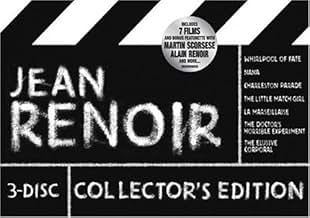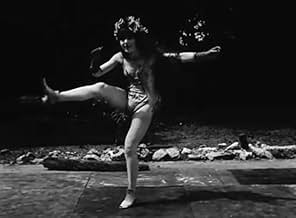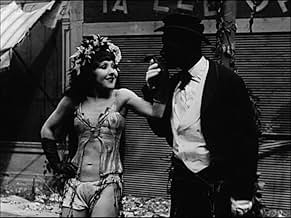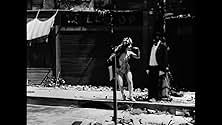Agrega una trama en tu idiomaShot in three days, this surreal, silent short shows a native white girl teaching a futuristic African airman the Charleston dance.Shot in three days, this surreal, silent short shows a native white girl teaching a futuristic African airman the Charleston dance.Shot in three days, this surreal, silent short shows a native white girl teaching a futuristic African airman the Charleston dance.
- Dirección
- Guionistas
- Elenco
- Dirección
- Guionistas
- Todo el elenco y el equipo
- Producción, taquilla y más en IMDbPro
Opiniones destacadas
Charleston Parade (1927)
** 1/2 (out of 4)
Extremely bizarre short film from Jean Renoir is somewhat sci-fi and somewhat musical. A man in blackface takes off in a spaceship and lands in an unknown country. In this country he meets a white woman (Catherine Hessling; the director's wife) who does a tribal dance, which the blackface man believes is from his native people. I'm really not sure what the hell this film is suppose to be about but I can only guess it has something to do with reverse racism. There are several racial comments made by the white girl and her "not liking black meat" and I guess her being the "native" doing a tribal dance was the reverse thing from the black man doing it, which is something we've seen in countless films from this period. The DVD doesn't feature any music score so it was somewhat hard to know the nature the director was going for. An interesting short to say the least.
** 1/2 (out of 4)
Extremely bizarre short film from Jean Renoir is somewhat sci-fi and somewhat musical. A man in blackface takes off in a spaceship and lands in an unknown country. In this country he meets a white woman (Catherine Hessling; the director's wife) who does a tribal dance, which the blackface man believes is from his native people. I'm really not sure what the hell this film is suppose to be about but I can only guess it has something to do with reverse racism. There are several racial comments made by the white girl and her "not liking black meat" and I guess her being the "native" doing a tribal dance was the reverse thing from the black man doing it, which is something we've seen in countless films from this period. The DVD doesn't feature any music score so it was somewhat hard to know the nature the director was going for. An interesting short to say the least.
A man in blackface lands in a spaceship and meets a girl who lives in some sort of shack with a monkey. He hooks her up with a telephone, and she teaches him how to Charleston. Then they fly off in the spaceship, leaving the monkey behind. Cringe-inducing blackface aside, this short film makes no sense. I think that's the plot, but I'm not sure by a long shot. You can't tell that this is Renoir at work, despite his characteristic humanism. Good use of slow-motion, though. Can be found on the NY Film Annex's series of Experimental Film videos, No. 18, I believe.
I enjoy science-fiction just as much as the next man
but what the hell was that? Apparently shot over just three days using excess film stock left over from his previous film, 'Nana (1926),' this Jean Renoir short is a bewildering futuristic satire, produced on a budget that couldn't have been much more than zero. In the year 2028, following a great war, Africa has become the most civilised region on Earth, and what was formerly Europe has been designated "Terres Inconnues (Unknown Land)." An African explorer played by Johnny Huggins, a Black man dressed up as a White man dressed up as a Black man, if you follow me travels to the ruins of Paris in his spherical aircraft, and lands outside the lair of a Parisian savage (Catherine Hessling, then the director's wife) and her primate companion, perhaps the creepiest ape-man costume I've ever seen. The savage, as part of some bizarre sexual initiation ritual, starts showing the explorer the Charleston dance, which he is delighted to learn himself.
It doesn't help the film that Hessling, who was wonderful the following year in Renoir's 'The Little Match Girl (1928),' isn't much of a dancer, though the extensive use of slow-motion adds a touch of surrealism to the ceremony. Furthermore, I'm quite shocked that Renoir would exploit his own wife as such a blatant sexual object it doesn't come as a surprise to learn of their divorce just three years later! On the plus side, I did like the general sci-fi concept behind the film, and the slyly satiric touch of the reversing the racial roles usually typical in such stories as this. However, why Renoir decided to dress up his Black actor as a minstrel will remain a mystery for all of time. Silly, crude and quite pointless, 'Charleston Parade (1927)' is a cinematic oddity from one of cinema's most respected directors, and is perhaps an effort that he would have liked to forget. The DVD version came without a musical soundtrack, but I compromised with a selection of pieces from Dmitri Shostakovich.
It doesn't help the film that Hessling, who was wonderful the following year in Renoir's 'The Little Match Girl (1928),' isn't much of a dancer, though the extensive use of slow-motion adds a touch of surrealism to the ceremony. Furthermore, I'm quite shocked that Renoir would exploit his own wife as such a blatant sexual object it doesn't come as a surprise to learn of their divorce just three years later! On the plus side, I did like the general sci-fi concept behind the film, and the slyly satiric touch of the reversing the racial roles usually typical in such stories as this. However, why Renoir decided to dress up his Black actor as a minstrel will remain a mystery for all of time. Silly, crude and quite pointless, 'Charleston Parade (1927)' is a cinematic oddity from one of cinema's most respected directors, and is perhaps an effort that he would have liked to forget. The DVD version came without a musical soundtrack, but I compromised with a selection of pieces from Dmitri Shostakovich.
Licking his wounds after the catastrophic failure of his 1926 version of 'Nana', starring his then-wife (1920-30) Catherine Hessling, Jean Renoir cheered himself up by making the nearest he ever came to science fiction with this exuberant romp set in the year 2028 displaying the impressively athletic dancing ability and lack of inhibition of the baby-faced Ms Hessling.
Arriving in the shattered remnants of Paris in a spherical spaceship that resembles 'Rover' from 'The Prisoner', a smartly dressed visitor from the African continent - where civilisation now resides since Europe blew itself to smithereens - is confronted by a scantily clad savage (her skimpy outfit enhanced by wrist-length gloves) played by Ms Hessling; and joins her in an energetic dancing duel facilitated by some pretty far-out trick photography. (Renoir anticipates Kubrick by forty years by going into negative to depict his flight.) The 'minstrel' makeup worn by Johnny Hudgins in the lead can't be blamed on Renoir since it was adopted by Hudgins himself in his stage act of the time.
If this had ever been intended for public exhibition it would have been a supreme example of pre-code filmmaking. Great fun.
Arriving in the shattered remnants of Paris in a spherical spaceship that resembles 'Rover' from 'The Prisoner', a smartly dressed visitor from the African continent - where civilisation now resides since Europe blew itself to smithereens - is confronted by a scantily clad savage (her skimpy outfit enhanced by wrist-length gloves) played by Ms Hessling; and joins her in an energetic dancing duel facilitated by some pretty far-out trick photography. (Renoir anticipates Kubrick by forty years by going into negative to depict his flight.) The 'minstrel' makeup worn by Johnny Hudgins in the lead can't be blamed on Renoir since it was adopted by Hudgins himself in his stage act of the time.
If this had ever been intended for public exhibition it would have been a supreme example of pre-code filmmaking. Great fun.
This is, by far, Jean Renoir's oddest film: a surreal, sci-fi/musical short which was originally accompanied by a specially-composed score but whose print on the DVD itself, bafflingly, features no underscoring whatsoever. Incongruously enough, the film apparently grew out of Renoir's desire to utilize footage left over from NANA (1926)!
Again, we find Renoir's wife at the time Catherine Hessling in a major role; here, she is a sexy dancer from the future who teaches a sophisticated negro explorer(!) the Charleston dance (at which he eventually proves himself remarkably adept). It is very hard to believe now that Hessling's dancing caused quite a stir at the time but there you go. Unfortunately, the film doesn't add up to much and there's practically nothing of the traditional Renoir on display. Besides, its premise isn't enough to sustain even the film's two-reel length, with the protracted dance sequence itself, filmed at a variety of speeds, emerging as a hollow exercise in style.
For what it's worth, other characters appearing in the film include a (fake-looking) monkey who is Hessling's sole companion on the seemingly deserted place the coloured astronaut lands on and, for no apparent reason, a group of grinning angels (among them Renoir himself)! The film's best gag is one that would soon become a staple of animation: at one point, Hessling draws a telephone on a wall and this immediately materializes into the real thing.
Again, we find Renoir's wife at the time Catherine Hessling in a major role; here, she is a sexy dancer from the future who teaches a sophisticated negro explorer(!) the Charleston dance (at which he eventually proves himself remarkably adept). It is very hard to believe now that Hessling's dancing caused quite a stir at the time but there you go. Unfortunately, the film doesn't add up to much and there's practically nothing of the traditional Renoir on display. Besides, its premise isn't enough to sustain even the film's two-reel length, with the protracted dance sequence itself, filmed at a variety of speeds, emerging as a hollow exercise in style.
For what it's worth, other characters appearing in the film include a (fake-looking) monkey who is Hessling's sole companion on the seemingly deserted place the coloured astronaut lands on and, for no apparent reason, a group of grinning angels (among them Renoir himself)! The film's best gag is one that would soon become a staple of animation: at one point, Hessling draws a telephone on a wall and this immediately materializes into the real thing.
¿Sabías que…?
- TriviaJean Renoir's debut as an actor.
- ConexionesFeatured in Jean Renoir: Part One - From La Belle Époque to World War II (1993)
Selecciones populares
Inicia sesión para calificar y agrega a la lista de videos para obtener recomendaciones personalizadas
Detalles
- Tiempo de ejecución17 minutos
- Color
- Mezcla de sonido
- Relación de aspecto
- 1.33 : 1
Contribuir a esta página
Sugiere una edición o agrega el contenido que falta


















